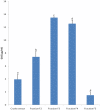Antioxidant and antimicrobial activities of ethyl acetate extract, fractions and compounds from stem bark of Albizia adianthifolia (Mimosoideae)
- PMID: 22809287
- PMCID: PMC3488965
- DOI: 10.1186/1472-6882-12-99
Antioxidant and antimicrobial activities of ethyl acetate extract, fractions and compounds from stem bark of Albizia adianthifolia (Mimosoideae)
Abstract
Background: Albizia adianthifolia is used traditionally in Cameroon to treat several ailments, including infectious and associated diseases. This work was therefore designed to investigate the antioxidant and antimicrobial activities of ethyl acetate extract, fractions and compounds isolated from the stem bark of this plant.
Methods: The plant extract was prepared by maceration in ethyl acetate. Its fractionation was done by column chromatography and the structures of isolated compounds were elucidated using spectroscopic data in conjunction with literature data. The 1,1-diphenyl-2-picrylhydrazyl (DPPH) and trolox equivalent antioxidant capacity (TEAC) assays were used to detect the antioxidant activity. Broth micro-dilution method was used for antimicrobial test. Total phenol content was determined spectrophotometrically in the extracts by using Folin-Ciocalteu method.
Results: The fractionation of the extract afforded two known compounds: lupeol (1) and aurantiamide acetate (2) together with two mixtures of fatty acids: oleic acid and n-hexadecanoic acid (B₁); n-hexadecanoic acid, octadecanoic acid and docosanoic acid (B₂). Aurantiamide acetate was the most active compound. The total phenol concentration expressed as gallic acid equivalents (GAE) was found to vary from 1.50 to 13.49 μg/ml in the extracts. The antioxidant activities were well correlated with the total phenol content (R² = 0.946 for the TEAC method and R² = 0.980 for the DPPH free-radical scavenging assay).
Conclusions: Our results clearly reveal that the ethyl acetate extract from the stem bark of A. adianthifolia possesses antioxidant and antimicrobial principles. The antioxidant activity of this extract as well as that of compound 2 are being reported herein for the first time. These results provide promising baseline information for the potential use of this plant as well as compound 2 in the treatment of oxidative damage and infections associated with the studied microorganisms.
Figures





Similar articles
-
Antimicrobial and antioxidant properties of methanol extract, fractions and compounds from the stem bark of Entada abyssinica Stend ex A. Satabie.BMC Complement Altern Med. 2011 Jul 19;11:57. doi: 10.1186/1472-6882-11-57. BMC Complement Altern Med. 2011. PMID: 21771305 Free PMC article.
-
Antimicrobial and antioxidant flavonoids from the leaves of Oncoba spinosa Forssk. (Salicaceae).BMC Complement Altern Med. 2015 Apr 28;15:134. doi: 10.1186/s12906-015-0660-1. BMC Complement Altern Med. 2015. PMID: 25928352 Free PMC article.
-
Antimicrobial and antioxidant activities of the extracts and compounds from the leaves of Psorospermum aurantiacum Engl. and Hypericum lanceolatum Lam.BMC Complement Altern Med. 2012 Aug 24;12:136. doi: 10.1186/1472-6882-12-136. BMC Complement Altern Med. 2012. PMID: 22916964 Free PMC article.
-
Hop Compounds: Extraction Techniques, Chemical Analyses, Antioxidative, Antimicrobial, and Anticarcinogenic Effects.Nutrients. 2019 Jan 24;11(2):257. doi: 10.3390/nu11020257. Nutrients. 2019. PMID: 30678345 Free PMC article. Review.
-
Antioxidant and Antimicrobial Peptides Derived from Food Proteins.Molecules. 2022 Feb 16;27(4):1343. doi: 10.3390/molecules27041343. Molecules. 2022. PMID: 35209132 Free PMC article. Review.
Cited by
-
Biochemical composition and antioxidant capacity of extracts from Podophyllum hexandrum rhizome.BMC Complement Altern Med. 2012 Dec 22;12:263. doi: 10.1186/1472-6882-12-263. BMC Complement Altern Med. 2012. PMID: 23259745 Free PMC article.
-
Electrochemical behavior and in-vitro antimicrobial screening of some thienylazoaryls dyes.Chem Cent J. 2017 Nov 21;11(1):119. doi: 10.1186/s13065-017-0345-6. Chem Cent J. 2017. PMID: 29159480 Free PMC article.
-
Protocorm-like-body extract of Phalaenopsis aphrodite combats watermelon fruit blotch disease.Front Plant Sci. 2022 Nov 29;13:1054586. doi: 10.3389/fpls.2022.1054586. eCollection 2022. Front Plant Sci. 2022. PMID: 36523623 Free PMC article.
-
Hepatoprotective effect of the solvent extracts of Viola canescens Wall. ex. Roxb. against CCl4 induced toxicity through antioxidant and membrane stabilizing activity.BMC Complement Altern Med. 2017 Jan 5;17(1):10. doi: 10.1186/s12906-016-1537-7. BMC Complement Altern Med. 2017. PMID: 28056938 Free PMC article.
-
Memory-enhancing activities of the aqueous extract of Albizia adianthifolia leaves in the 6-hydroxydopamine-lesion rodent model of Parkinson's disease.BMC Complement Altern Med. 2014 Apr 30;14:142. doi: 10.1186/1472-6882-14-142. BMC Complement Altern Med. 2014. PMID: 24884469 Free PMC article.
References
-
- Zabala NQ. Albizia and Paraserianthes species. Proceedings of an international workshop held in Bislig, Suriqao; del Sur, Philippines; 1997. pp. 13–19.
-
- Watt JM, Breyer-Brandwyk MG. The medicinal and poisonous plants of Southern and Easthern Africa. 2. Livingstone, London; 1962.
-
- Van-Wyk BE, Gerick N. People’s plants: a guide to useful plants of Southern Africa. Briza publications, Pretoria; 2000.
-
- Candy HA, Brookes KB, Bull JR, Mc Garry EJ, Mc Garry JM. Flavonoids of Albizia adianthifolia. Phytochemistry. 1978;17:1681–1682. doi: 10.1016/S0031-9422(00)94678-8. - DOI
Publication types
MeSH terms
Substances
LinkOut - more resources
Full Text Sources
Medical

